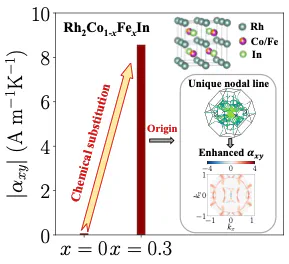Chemical-substitution-driven giant anomalous Hall and Nernst effects in magnetic cubic Heusler compounds
Jan 1, 2024· ,,,·
0 min read
,,,·
0 min read
Guangzong Xing
Keisuke Masuda
Terumasa Tadano
Yoshio Miura

Abstract
Chemical doping provides an efficient way to optimize the physical properties of magnetic Heusler compounds, especially the anomalous transport properties, including the anomalous Hall conductivity (AHC) and anomalous Nernst conductivity (ANC).In this study, we systematically investigated the effect of chemical doping on AHC and ANC in 1493 Heusler compounds using high-throughput first-principles calculations. Our investigation reveals notable trends in Co- and Rh-based Heusler compounds, where chemical doping effectively enhances the AHC and ANC. Intriguingly, several doped candidates exhibit outstanding enhancement of AHC and ANC (at 300 K), such as (Co$_{0.8}$Ni$_{0.2}$)$_2$FeSn with both giant AHC of -2567.78 S cm$^{-1}$ and ANC of 8.27 A m$^{-1}$K$^{-1}$, and Rh$_2$Co$_{0.7}$Fe$_{0.3}$In with ANC of 8.57 A m$^{-1}$K$^{-1}$. Significantly, such a substantial ANC value as observed in Rh$_2$Co$_{0.7}$Fe$_{0.3}$In is not present in the stoichiometric mother compound Rh$_2$CoIn, which exhibits a maximum ANC value of 4.36 A m$^{-1}$K$^{-1}$ located at 0.3 eV above the Fermi energy. A comprehensive band structure analysis underscores that the notable enhancement in ANC within doped compounds arises from the creation and modification of nodal lines accompanied by the shift of the Fermi energy through chemical doping. This mechanism generates a robust Berry curvature slightly above the Fermi energy, resulting in significant ANC. These findings emphasize the pivotal role of chemical doping in engineering high-performance materials, thereby expanding the horizons of transport property optimization within Heusler compounds.
Type
Publication
Acta Mater.